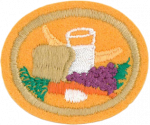AY Honors/Nutrition/Answer Key/es
| Nutrición | ||
|---|---|---|
| Asociación General
|
Destreza: 1 Año de introducción: 1981 |
|
Requisitos
|
La especialidad de Nutrición es un componente de la Maestría Artes Domésticas. |
1. Dibujar la pirámide alimenticia en sus varias formas. Decir el número de porciones necesarias de cada grupo por día. ¿Por qué es importante comer una dieta balanceada?
2. Explicar la diferencia entre las siguientes clases de dieta:
a. Ovolactovegetarianismo
b. Ovovegetarianismo
c. Veganismo
3. Planear un menú de 2 días de una dieta ovolactovegetariana balanceada utilizando el guía de la pirámide alimentaria.
4. ¿Cuál es otro nombre para las siguientes vitaminas?
a. Vitamina B1
b. Vitamin B2
5. Hacer una lista de al menos 3 importantes fuentes alimenticias de los siguientes nutrientes:
- a. Vitamina C:
- b. Vitamina A:
- c. Vitamina B1:
- d. Vitamin B2:
- e. Hierro:
- f. Calcio:
6. ¿Por qué es importante beber mucha agua cada día? ¿Cuánta agua se debería beber todos los días?
7. Nombrar 3 enfermedades comunes que pueden ser controladas por la dieta.
Cancer: The consensus on diet and cancer is that obesity increases the risk of developing cancer. Particular dietary practices often explain differences in cancer incidence in different countries (e.g. gastric cancer is more common in Japan, while colon cancer is more common in the United States). Studies have shown that immigrants develop the risk of their new country, suggesting a link between diet and cancer rather than a genetic basis.
8. What is the difference between whole wheat flour and white flour, and which one has the higher nutritive value?
The two biggest differences between white bread and whole wheat are the processing and the nutritional value. Whole wheat flour has the higher nutritive value.
Flour is made from wheat berries. The wheat berry is made up of the bran, the germ and the endosperm. All parts are filled with nutrients and are used in whole wheat flour.
White bread on the other hand, uses only the endosperm - the starchy inner layer. There are a total of 30 nutrients present in whole wheat bread that are missing in white bread. The nutritional difference is immense and has measurable impact on our health.
The fiber content of whole wheat bread has several health benefits.
Fiber helps the digestive system. It also creates a 'full' sensation and thus can help with weight control. Research has been conducted by Harvard and other organizations that shows men and women who eat high-fiber foods are less likely to have heart attacks and strokes as compared to those who don't.
There is also an increased risk of diabetes in children who eat refined white flour - a risk that has been proven by the increase in cases of childhood diabetes.
9. What does RDA stand for? What does it mean?
Recommended Dietary Allowance (RDA) is the daily dietary intake level of a nutrient that is considered sufficient to meet the requirements of nearly all (97-98%) healthy individuals in each life-stage and gender group. The RDAs are established by the Food and Nutrition Board of the (US) National Academy of Sciences.
10. Why is it important not to take excessive amounts of some vitamins and minerals?
Fat-soluble vitamins may be stored in the body and can cause toxicity when taken in excess. Water-soluble vitamins are not stored in the body, with the exception of Vitamin B12, which is stored in the liver.
Some of the most common causes of vitamin poisoning are vitamins A, B3 and B6. Conversely, certain vitamins do not produce toxicity in excess levels: vitamin C has been used in clinical trials in dosages over 100,000 mg — over 1000 times the daily recommended intake — without ill effects.
Excess doses of mineral supplements can also lead to poisoning. Either or both of vitamin poisoning and mineral supplement poisoning can occur due to excessive intake of multivitamin supplements.
References
- Categoría: Tiene imagen de insignia
- Adventist Youth Honors Answer Book/Honors/es
- Adventist Youth Honors Answer Book/es
- Adventist Youth Honors Answer Book/Skill Level 1/es
- Categoría: Libro de respuestas de especialidades JA/Especialidades introducidas en 1981
- Adventist Youth Honors Answer Book/General Conference/es
- Adventist Youth Honors Answer Book/Unknown/es
- Adventist Youth Honors Answer Book/Unknown/Primary/es
- Adventist Youth Honors Answer Book/Stage 100/es
- Adventist Youth Honors Answer Book/Homemaking Master Award/es
- Adventist Youth Honors Answer Book
- Adventist Youth Honors Answer Book/Completed Honors

